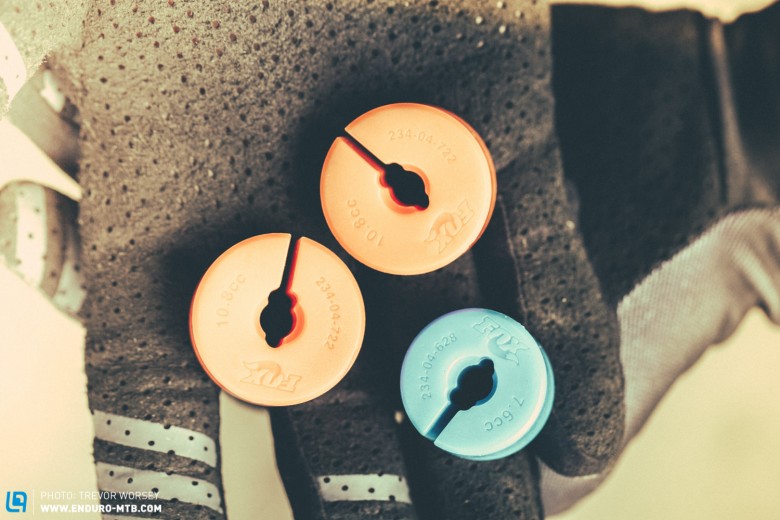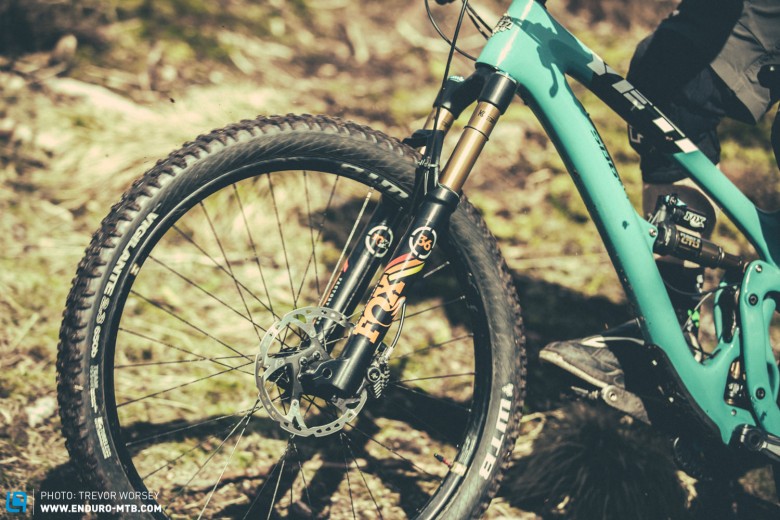Enduro Long Term Test | Review 2015 FOX 36 RC2

For many years, if you wanted to have the best suspension fork, it needed to have Fox written on the side of it, and for big mountain adventures the mighty 36 was king. But when the all-black Rockshox Pike hit the market everything changed, the svelte chassis and low weight made the old Fox 36 look bloated, heavy and dated. We have been testing the latest 2015 Fox 36 in our Long Term Program, it’s time to find out if the new fork can rekindle its formidable reputation.
While the Pike enjoyed deserved enduro domination the Fox 36 fought on for a few years in the shadows before almost fading into the background. Then like a phoenix from the ashes the Fox 36 was back, slimmed down (to just 1901g) and ready for a fight. Almost overnight the 2015 Fox 36 RC2 became the fork of choice for the top racers, and once again riders were left with a difficult choice, RockShox or Fox?

The Fox 36 vs the Rockshox Pike
We included the Fox 36 in our recent enduro race fork group test, and found that the incredible sensitivity, stiffness and performance over rocky ground lifted it above the rest to take the title of ‘Best in test’. We have six 2015 Fox 36’s (five Float RC2 and a Talas) currently working hard on the test fleet (link here) and have racked up over 900 hours of cumulative testing. In the past, the Fox 36 gained somewhat of a reputation of being a little high maintenance, so it’s time to find out if the new fork has been improved.

The performance of the 2015 Fox 36 RC2
Before we get into the nitty gritty, let’s talk about performance. If you have not ridden the latest generation of 36’s – a lot has changed. The Fox 36 RC2 damper cartridge has been re-designed with a new air spring that auto-equalises the positive and negative air chambers to improve small bump compliance and resulting in less resistance in the stroke. However the most eagerly anticipated improvement is that volume spacers can now be added to adjust the spring rate if required, making the fork much more customisable to the needs of heavier or more aggressive riders. The air spring rate can be adjusted to suit using two sizes of volume spacers, and the wide range of compression and rebound adjustments allow you to fine tune the fork to exactly how you want it.



In use the first 20% of fork travel is beautifully smooth and linear, eating up small bumps without fuss, providing massive levels of traction as it tracks the terrain contours like a bloodhound on a scent. Should you hit a big square edge the fork responds instantly controlling the impact and dissipating the forces without a harsh top out. The ride is magic carpet smooth and lets you concentrate on the important stuff – like staying out of the trees! The chassis is impressively stiff and provides lazer sharp steering accuracy, even when the trail is going to hell and rocks are flying everywhere. The pinch bolt drop outs are impressively burly and there is little unwanted flex or vibration at the axle, even when running the smaller 15mm thru axle. When pushing the fork into big high speed G-outs the powerful chassis inspires confidence and never feels outgunned.


What really impressed our testers was the range provided by the HSC (High Speed Compression) and LSC (Low Speed Compression) adjusters allowing easy and dramatic adjustment of the fork’s performance. If you want the fork to stand up higher in its travel on steeper terrain a few clicks more LSC keep everything under control, or if you want maximum traction a few clicks less glue the wheel to the ground. Most of our testers were running settings around 4-6 clicks from fully open HSC and 4-6 clicks of LSC with between 7-10 clicks of rebound damping depending on trail conditions, and most had opted to fit 1-2 spacers for a more progressive spring rate. We have not experienced any issues blowing rebound cartridges or compression issues – despite frequent races.
Long Term Reliability of 2015 Fox 36 RC2
So the performance is unquestioned, but have Fox improved on service requirements? Fox used to recommend cleaning and inspecting the dust seals, a fiddly job which required popping them out from the lowers every 25 hours! This was a regime that few riders adhered too, who has time for that? The latest generation of seals require less maintenance and Fox now recommend a servicing interval of every 125 hours (or yearly if that comes first) which includes, and we quote, “Full fork service (Full internal/external inspection, damper rebuild, air spring rebuild, bath oil and wiper replacement”. We spoke to Chris Trojer at Fox about this and his advice was “what I recommend is to always do a basic lower service after every 50 hours of riding. But again, this is a recommendation, not a mandatory thing. This can be done really easily and if you have 50 hours of fun on your bike, 20 minutes for a quick lower service is not that big investment timewise.” You can see a great service video here.

The normal cause for poor performance is grime and dirt getting past the dust seals and creating an abrasive paste inside the fork. All the forks in our test have been serviced at least once within the 125 hour service schedule, and one was run for twice the service interval to check the seal integrity. When it was stripped down the oil was still clear and uncontaminated (despite a Scottish winter) showing the seals are doing a good job keeping the grime out. What we have noticed is that the new 36 shows less of a steady decline in performance between servicing, the old fork used to be night and day after a service, but the 2015 model works well beyond its interval.


We have been very impressed with the performance but it’s not all been plain sailing. Like any high performance product the Fox 36 requires attention to keep it working at its best and we did experience drying seals in one of the forks which resulted in stiction in the initial phases of travel which was fixed with a lube and service. We also managed to bend part of the damper inside another after 8 rides, but that was sorted quickly under warranty.
How to look after a 2015 Fox 36 RC2
We look after our forks and always follow three simple rules. We store the bike upside-down to get the lubrication oil back to the foam rings under the seal and always clean the stanchion tubes and seal area with a soft towel after every ride. Also we never apply any oil out of spray cans onto the stanchion tube, as some lubricants can cause rubber to swell and reduce the performance of the seal.
Even though our test team are well used to suspension servicing we found it a very simple task. Many riders fear delving into their suspension, considering it witchcraft and voodoo, often choosing to send them off for a service instead (or even worse taking no action at all). But in reality it is just o-rings and oil and as long as you can tell the difference between clockwise and anticlockwise and can wield a spanner we recommend giving it a go (there are lots of excellent service videos online). Even if you limit yourself to a simple bath oil change, familiarity with the inside of your fork will not only increase your understanding of what’s going on, but also allow you to catch any potential wear issues early. If your forks start to perform poorly or make unusual noises, that’s the time to send them to an expert.


Do we like the 2015 Fox 36 RC2 pinch clamp?
All the models in the current test fleet are 2015 models and feature the pinch clamp wheel mounting. The clamping system is annoying and it’s easy for ham fisted mechanics to screw the bolts in too tight and shear them. However, the pinch clamp is lighter than a QR and many would argue that the un-tightened floating right leg results in less binding in the bushings and less wear. With care we have experience no problems with the pinch bolts – the trick is to be gentle! For 2016 Fox will be offering a 15mm QR axle for riders who want more ease of use.

Fox 36 RC2 Long Term Review Conclusion
The 2015 Fox 36 RC2 is certainly an outstanding performer, and we have been impressed with the improved service intervals and seals. All the forks still look factory fresh inside despite going through a tough winter, and despite a sticky seal and one malfunction they are performing exceptionally well.
Words and photos: Trev Worsey
Did you enjoy this article? If so, we would be stoked if you decide to support us with a monthly contribution. By becoming a supporter of ENDURO, you will help secure a sustainable future for high-quality mountain bike journalism. Click here to learn more.








